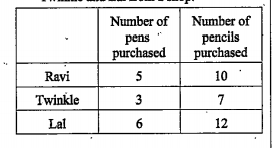In each of the following cases, states whether the function is one-one,
onto or bijective. Justify your answer. f:R→R defined by f(x) =3 - 4x Solution in Malayalam
Step by step video & image solution for In each of the following cases, states whether the function is one-one, onto or bijective. Justify your answer. f : R rarr R defined by f(x) =3 - 4x by Maths experts to help you in doubts & scoring excellent marks in Class 12 exams.
Updated on:21/07/2023Topper's Solved these Questions
Similar Questions
Consider the following information regarding the purchase of pens and penciles by the three students Ravi, Twinkle and Lal from a shop.
 Represent the above data in the form of a 3×2 matrix. What does the entry in the 2nd row and in the first column represent?
Represent the above data in the form of a 3×2 matrix. What does the entry in the 2nd row and in the first column represent?
View SolutionLet A be the set of all 50 students of class X in a school. Let f:A→N
be function defined by f(x) = roll numbers of the student x. Show that
f is one-one but not onto
View SolutionIn each of the following cases, state whether the function is one-one, onto or bijective. Justify your answer.
(i) f:R→R,defined by f(x)=3−4x
(ii) f:R→R,defined by f(x)=1+x2
View Solutionनिम्नलिखित में से प्रत्येक स्थिति में बतलाइए कि क्या दिए हुए फलन एकैकी, आच्छादक अथवा एकैकी आच्छादी (bijective) हैं। अपने उत्तर का औचित्य भी बतलाइए।
(i) f(x)=3−4x द्वारा परिभाषित फलन f:R→R है।
(ii) f(x)=1+x2 द्वारा परिभाषित फलन f:R→R है।
View SolutionIn each of the following cases state whether the functions is bijective or not. Justify your answer:
f:R→Rdef∈edbyf(x)=2x+1
View SolutionIn each of the following cases state whether the functions is bijective or not. Justify your answer:
f:R→R defined by f(x)=3−4x2
View Solutionनिम्नलिखित में से प्रत्येक स्थिति में बताइए कि क्या दिये हुए फलन एकैकी, आच्छादक अथवा आच्छादी (bijective) हैं। अपने उत्तर का औचित्य भी बताइए :
(a) f(x)=3−4x द्वारा परिभाषित फलन f:R→R है।
(b) f(x)=x2+1 द्वारा परिभाषित फलन f:R→R है।
View SolutionIn each of the following cases, state whether the function is one-one onto or bijective. Justify your answwer.
(i)f:R→R defined by f(x)=3−4x
(ii) f:R→R defined by f(x)=1+x2
View SolutionIn each of the following cases, state whether the function is one-one onto or bijective. Justify your answwer.
(i)f:R→R defined by f(x)=3−4x
(ii) f:R→R defined by f(x)=1+x2
View SolutionIn each of the following cases, state whether the function is one-one, onto or bijective. Justify your answer.
(i)f:R→R defined by f(x)=3−4x
(ii) f:R→R defined by f(x)=1+x2
View SolutionIn each of the following cases, state whether the function is one-one onto or bijective. Justify your answwer.
(i)f:R→R defined by f(x)=3−4x
(ii) f:R→R defined by f(x)=1+x2
View SolutionIn each of the following cases, state whether the function is one-one, onto or bijective. Justify your answer.(i) f:R→R,defined by f(x)=34x(ii) f:R→R,defined by f(x)=1+x2
View SolutionIn each of the following cases , state whether the function is one - one , onto or bijective. Justify your answer.
f:R→R defined by f(x) = 3−4x.
View SolutionIn each of the following cases , state whether the function is one - one , onto or bijective. Justify your answer.
f:R→R defined by f(x) = 1+x2
View SolutionIn each of the following cases, states whether the function is one-one,
onto or bijective. Justify your answer. f:R→R defined by f(x) =3 - 4x
View SolutionIn each of the following cases, states whether the function is one-one,
onto or bijective. Justify your answer. f:R→R defined by f(x) = 1+x2
View Solution
